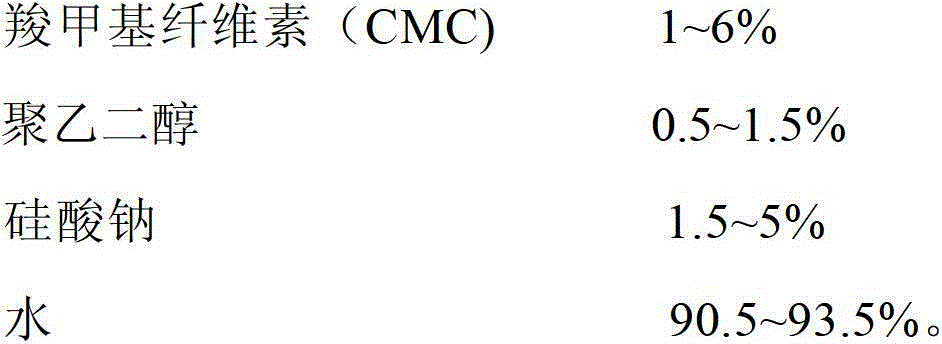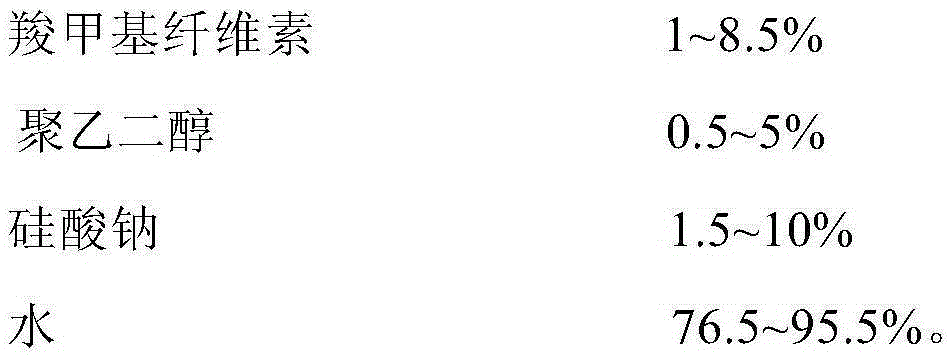An inhibitor for controlling dust pollution in the process of collecting and transporting domestic garbage and its preparation and application
A technology for domestic waste and dust pollution, applied in other chemical processes, chemical instruments and methods, etc., can solve the problems of secondary pollution, high price, refractory degradation, etc. Effect
- Summary
- Abstract
- Description
- Claims
- Application Information
AI Technical Summary
Problems solved by technology
Method used
Image
Examples
Embodiment 1
[0041] Example 1: Used in garbage transportation process
[0042] Take carboxymethyl cellulose (weight average molecular weight: 156,000, degree of substitution: 0.92) 5.0 kg, polyethylene glycol (weight average molecular weight: 400) 1.5 kg, sodium silicate 3.0 kg, mix in a mixer and add water 90.5kg, fully stirred at room temperature for 10-15 minutes, it is the finished product.
[0043] Acute skin irritation / corrosion tests were conducted according to the "Technical Specifications for the Identification of Chemical Toxicity" of the Ministry of Health. The test results showed that the irritation intensity was zero, which was non-irritating. According to the "Chemical Testing Guidelines" (HJ / T153-2004) acute oral toxicity test method, the test of the bacteriostatic agent's acute oral toxicity (LD 50 ): male rat> 4500mg / kg, female rat> 4500mg / kg. According to the "Guidelines for the Hazard Assessment of New Chemical Substances" (HJ / T154-2004), the oral acute toxicity classificati...
Embodiment 2
[0048] Example 2: Used in garbage loading and unloading process
[0049] Take 1.0 kg of carboxymethyl cellulose (weight average molecular weight: 145,000, degree of substitution: 0.90), polyethylene glycol 0.5 kg (weight average molecular weight: 300), and 5.0 kg of sodium silicate, and add water after mixing in a mixer 93.5kg, fully stirred at room temperature for 10-15 minutes, it is the finished product.
[0050] Acute skin irritation / corrosion tests were conducted according to the "Technical Specifications for the Identification of Chemical Toxicity" of the Ministry of Health. The test results showed that the irritation intensity was zero, which was non-irritating. According to the "Chemical Testing Guidelines" (HJ / T153-2004) acute oral toxicity test method, the test of the bacteriostatic agent's acute oral toxicity (LD 50 ): male rat> 4500mg / kg, female rat> 4500mg / kg. According to the "Guidelines for the Hazard Assessment of New Chemical Substances" (HJ / T154-2004), the oral a...
Embodiment 3
[0055] Example 3: Used in the garbage dumping process
[0056] Take 6.0 kg of carboxymethyl cellulose (weight average molecular weight: 123,000 degree of substitution: 0.88), polyethylene glycol 1.0 kg (weight average molecular weight: 400), 1.5 kg of sodium silicate, mix in a mixer and add water 91.5 kg, fully stirred at room temperature for 10-15 minutes, it is the finished product.
[0057] Acute skin irritation / corrosion tests were conducted according to the "Technical Specifications for the Identification of Chemical Toxicity" of the Ministry of Health. The test results showed that the irritation intensity was zero, which was non-irritating. According to the "Chemical Testing Guidelines" (HJ / T153-2004) acute oral toxicity test method, the test of the bacteriostatic agent's acute oral toxicity (LD 50 ): male rat> 4500mg / kg, female rat> 4500mg / kg. According to the "Guidelines for the Hazard Assessment of New Chemical Substances" (HJ / T154-2004), the oral acute toxicity classific...
PUM
| Property | Measurement | Unit |
|---|---|---|
| degree of substitution | aaaaa | aaaaa |
| degree of substitution | aaaaa | aaaaa |
Abstract
Description
Claims
Application Information
 Login to View More
Login to View More - R&D
- Intellectual Property
- Life Sciences
- Materials
- Tech Scout
- Unparalleled Data Quality
- Higher Quality Content
- 60% Fewer Hallucinations
Browse by: Latest US Patents, China's latest patents, Technical Efficacy Thesaurus, Application Domain, Technology Topic, Popular Technical Reports.
© 2025 PatSnap. All rights reserved.Legal|Privacy policy|Modern Slavery Act Transparency Statement|Sitemap|About US| Contact US: help@patsnap.com



